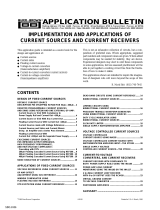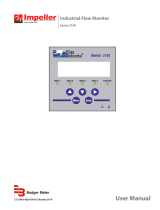Page is loading ...

99kΩ
RCV420
92kΩ300kΩ
75Ω
75Ω
300kΩ
1.01kΩ
11.5kΩ
10.0V
Ref
0 to 5V
Meter
10.0V to
5.0V
10.0V
Pseudo
Ground
12
15
10
11
HI
LO
Ref
In
Rcv
FB
14
Ref
Out
Ref
FB
Ref
Out
5
Ref
Com
13
Rcv
Com
4
V–
100kΩ
NC
(1)
3
+In
2
CT
1
–In
16
V+
+28V
(15V to 36V)
4-20mA
Input from
Current Loop
NOTE: (1) NC = No Connection.
FIGURE 1.
Many industrial current-loop data acquisition systems oper-
ate on a 24V or 28V single supply. You can make a single-
supply current loop receiver with the RCV420 by using its
10V reference as a pseudo ground. The RCV420 will con-
vert a 4-20mA loop current into a 0 to 5V output voltage
with no external components required. The current loop can
be sourcing or sinking and can be referenced to either the
power-supply V+ or ground.
The complete circuit for a single-supply current loop re-
ceiver is shown in Figure 1. In this application, a 4-20mA
current source referenced to power-supply ground drives the
receiver. The V– terminal and the Ref Com terminal of the
RCV420 are both tied to power supply ground. The 10V
reference output (Ref Out) becomes a pseudo ground where
the current loop receiver common pin (Rcv Com) is tied. The
current loop receiver output is now referenced to the 10V
pseudo ground.
In normal operation, the 4-20mA current loop signal would
produce a 0-5V output with the RCV420 offset pin (Ref In)
connected to the +10V reference. The 10V reference pro-
vides a –1.25V offset so 4mA input current will produce 0V
out. In this application, the Ref In pin is connected to power
supply ground which acts as a –10V reference—producing
a +1.25V offset. Now with the inputs connected for an
inverted output signal, the RCV420 output will be 0 to –5V
referenced to the pseudo ground. Since the pseudo ground is
at 10V, the actual output will be 10V to 5V—a signal which
can drive most floating ground meters.
For a current loop receiver with a 4-20mA current sink
referenced to the power-supply V+, use the connection
shown in Figure 2.
The circuit can operate on a single supply ranging from
+15V to +36V (+44V absolute max). The pseudo ground
(Ref Out) can source or sink up to 5mA.
For an isolated single-supply 4-20mA current loop receiver,
you can connect the circuit to an isolation amplifier as
shown in Figure 3. In this circuit the ISO122 is operated
single-supply using the 10.0V pseudo ground. Note that the
output side of the isolation amplifier still requires dual
supplies.
Output from the ISO122 will be 0 to –5V. You could
interchange the input connections to the ISO122 to get a 0
to 5V output, but power-supply rejection would degrade
performance.
The ISO122 is a low-cost iso amp in a standard plastic DIP.
For a hermetic isolation amplifier, use the ISO120. Hook-up
details are shown in Application Bulletin AB-009.
SINGLE SUPPLY 4-20mA CURRENT LOOP RECEIVER
By R. Mark Stitt and David Kunst (602) 746-7445
APPLICATION BULLETIN
®
Mailing Address: PO Box 11400 • Tucson, AZ 85734 • Street Address: 6730 S. Tucson Blvd. • Tucson, AZ 85706
Tel: (602) 746-1111 • Twx: 910-952-111 • Telex: 066-6491 • FAX (602) 889-1510 • Immediate Product Info: (800) 548-6132
©
1992 Burr-Brown Corporation AB-041 Printed in U.S.A. June, 1992
SBOA023

2
FIGURE 2.
FIGURE 3.
99kΩ
RCV420
92kΩ300kΩ
75Ω
75Ω
300kΩ
1.01kΩ
11.5kΩ
10.0V
Ref
0 to 5V
Meter
10.0V to
5.0V
10.0V
Pseudo
Ground
12
15
10
11
HI
LO
Ref
In
Rcv
FB
14
Ref
Out
Ref
FB
Ref
Out
5
Ref
Com
13
Rcv
Com
4
V–
100kΩ
NC
(1)
3
+In
2
CT
1
–In
16
V+
+28V
(15V to 36V)
4-20mA
Input from
Current Loop
NOTE: (1) NC = No Connection.
99kΩ
RCV420
92kΩ300kΩ
75Ω
75Ω
300kΩ
1.01kΩ
11.5kΩ
10.0V
Ref
12
15
10
11
Ref
In
Rcv
FB
14
Ref
Out
Ref
FB
Ref
Out
5
Ref
Com
13
Rcv
Com
4
V–
100kΩ
NC
(1)
3
+In
2
CT
1
–In
16
V+
+28V
(15V to 36V)
4-20mA
Input from
Current Loop
NOTE: (1) NC = No Connection.
15
16
In
Gnd
ISO
122
1
9
10
7
8
Com 2
–V
S2
(–15V)
+V
S2
(+15V)
V
O
= 0 to –5V
2
–V
S1
The information provided herein is believed to be reliable; however, BURR-BROWN assumes no responsibility for inaccuracies or omissions. BURR-BROWN
assumes no responsibility for the use of this information, and all use of such information shall be entirely at the user’s own risk. Prices and specifications are subject
to change without notice. No patent rights or licenses to any of the circuits described herein are implied or granted to any third party. BURR-BROWN does not
authorize or warrant any BURR-BROWN product for use in life support devices and/or systems.

IMPORTANT NOTICE
Texas Instruments and its subsidiaries (TI) reserve the right to make changes to their products or to discontinue
any product or service without notice, and advise customers to obtain the latest version of relevant information
to verify, before placing orders, that information being relied on is current and complete. All products are sold
subject to the terms and conditions of sale supplied at the time of order acknowledgment, including those
pertaining to warranty, patent infringement, and limitation of liability.
TI warrants performance of its semiconductor products to the specifications applicable at the time of sale in
accordance with TI’s standard warranty. Testing and other quality control techniques are utilized to the extent
TI deems necessary to support this warranty. Specific testing of all parameters of each device is not necessarily
performed, except those mandated by government requirements.
Customers are responsible for their applications using TI components.
In order to minimize risks associated with the customer’s applications, adequate design and operating
safeguards must be provided by the customer to minimize inherent or procedural hazards.
TI assumes no liability for applications assistance or customer product design. TI does not warrant or represent
that any license, either express or implied, is granted under any patent right, copyright, mask work right, or other
intellectual property right of TI covering or relating to any combination, machine, or process in which such
semiconductor products or services might be or are used. TI’s publication of information regarding any third
party’s products or services does not constitute TI’s approval, warranty or endorsement thereof.
Copyright 2000, Texas Instruments Incorporated
/


